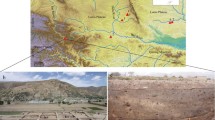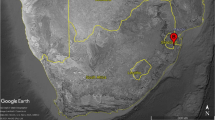Abstract
Ndondondwane in KwaZulu-Natal, South Africa, is an Early Iron Age site of a single, short-term occupation within the time period A.D. 750 to A.D. 950. This makes it a unique and ideal site to study cultural and social settlement organisation in this region. The site has been extensively excavated for archaeological research and a vast assemblage of charcoal retrieved. The charcoal assemblage was collected from three Cultural Horizons and each was analysed separately. This paper, the first to analyse the charcoal from this site, deals with charcoal collected from the deepest horizon represented by the livestock byre (Dung Area). Charcoal specimens were examined using reflective light microscopy to identify their characteristic anatomical features in order to determine the taxonomic group they represent. The majority of the charcoal from this layer was identified to six distinguishable species representing the genus previously known as Acacia, indicating this thorny wood was preferentially selected for constructing the byre and providing evidence for the usage of specific woody species for a particular purpose. In order to distinguish between the closely related species, a combination of morphological features was chosen and a comparison to modern charcoal reference samples and published wood anatomy descriptions were made. An attempt has been made to document the differences, as members of this genus are difficult to differentiate in terms of wood anatomy alone.




Similar content being viewed by others
References
Allott LF (2005) Palaeoenvironments of the Middle Stone Age at Sibudu Cave, KwaZulu-Natal, South Africa: an analysis of archaeological charcoal. PhD thesis, University of the Witwatersrand, Johannesburg
Allott LF (2006) Archaeological charcoal as a window on palaeovegetation and wood-use during the Middle Stone Age at Sibudu Cave. South Afr Humanit 18(1):173–201
Allue E, Picornell-Gelabert L, Daura J, Sanz M (2017) Reconstruction of the palaeoenvironment and anthropogenic activity from the upper pleistocene/holocene anthracological records of the NE Iberian peninsula (Barcelona, Spain). Quat Int 457:172–189
Asouti E, Austin P (2005) Reconstructing woodland vegetation and its exploitation by past societies, basedon the analysis and interpretation of archaeological wood charcoal macro-remains. Environ Archaeol 10:1–18
Barefoot AC, Hankins FW (1982) Identification of modern and tertiary woods. Clarendon Press, Oxford
Cartwright C, Parkington J (1997) The wood charcoal assemblage from Elands Bay Cave, southwestern Cape: principles, procedures and preliminary interpretation. S Afr Archaeol Bull 52:59–72
Chikumbirike J (2014) Archaeological and palaeoecological implications of charcoal assemblages dated to the Holocene from Great Zimbabwe and the hinterland. PhD thesis, University of the Witwatersrand, Johannesburg
Coates Palgrave K, Coates Palgrave M (2002) Palgrave’s trees of southern Africa. 3rd edn. Struik Publishers, Cape Town
Dechamps R (1993) Cle d’identification des Acacias Africaine. Tervuren, Belgium
Dotte-Sarout E, Kahn JG (2017) Ancient woodlands of Polynesia: a pilot anthracological study on Maupiti Island, French Polynesia. Quat Int 457:6–28
Dotte-Sarout E, Carah X, Byrne C (2015) Not just carbon: assessment and prospects for the application of anthracology in Oceania. Archaeol Ocean 50:1–22
Edwards D (1967) Plant ecology survey of the Tugela River Basin, Natal. Botanical Survey of South Africa: 36 (Natal Town and Regional Planning Commission report: 10)
Esterhuysen AB, Mitchell PJ (1996) Palaeoenvironmental and archaeological implications of the charcoal assemblage from Holocene sites in western Lesotho, southern Africa. Palaeoecol Afr 24:203–232
Fowler KD, Greenfield HJ (2009) Unravelling settlement history at Ndondondwane, South Africa: a micro-chronological analysis. South Afr Humanit 21:345–393
Fowler KD, Greenfield HJ, van Schalkwyk LO (2000) The identification and significance of ceramic ecofacts from Early Iron Age Ndondondwane, South Africa. South Afr Field Archaeol 9:32–42
Greenfield HJ (2006) On daga, houses, kraals, and the nature of intra-settlement spatial organization of EIA settlements in the EIA of southern Africa: a response to Whitelaw. Azania 41:167–180
Greenfield HJ, Miller D (2004) Spatial patterning of Early Iron Age metal production at Ndondondwane, South Africa: the question of cultural continuity between Early and Late Iron Ages. J Archaeol Sci 31:1511–1532
Greenfield HJ, van Schalkwyk L (2003) Intra-settlement social and economic organization of Early Iron Age farming communities in southern Africa: a view from Ndondondwane. Azania 38:121–137
Greenfield HJ, van Schalkwyk L, Jongsma TL (1997) Preliminary results of the 1995 research at the Early Iron Age site of Ndondondwane, KwaZulu-Natal, South Africa. Nyame Akuma 47: 42–52
Greenfield HJ, van Schalkwyk L, Jongsma TL (2000) Surface and subsurface reconnaissance at Ndondondwane: preliminary results of the 1995-97 field seasons. South Afr Field Archaeol 9:5–16
Greenfield HJ, Fowler KD, van Schalkwyk LO (2005) Where are the gardens? Early Iron Age horticulture in the Thukela River basin of South Africa. World Archaeol 37(2):307–328. https://doi.org/10.1080/00438240500095496
Huffman TN (1986) Archaeological evidence and conventional explanations of southern Bantu settlement patterns. Africa: J Int Afr Inst 56(3):280–298
Huffman TN (1990) Broederstroom and the origins of cattle-keeping in southern Africa. Afr Stud 49(2):1–12
Huffman TN (1993) Broederstroom and the central cattle pattern. S Afr J Sci 89:220–226
Huffman TN (2007) Handbook to the Iron Age: the archaeology of pre-colonial farming communities in southern Africa. University of KwaZulu-Natal Press, Pietermaritzburg
Kromhout CP (1975) 'n Sleutel vir die mikroskopiese uitkenning van die vernaamste inheemse houtsoorte van Suid-Afrika. South African Departement of Forestry, Pretoria
Lennox S (2016) Woody taxa from charcoal in Sibudu Middle Stone Age hearths. PhD thesis, University of the Witwatersrand, Johannesburg
Lennox S, Wadley L, Bamford M (2015) Charcoal analysis from 49 000-year-old hearths at Sibudu: implications for wood uses and the KwaZulu-Natal environment. S Afr Archaeol Bull 70(201):36–52
Liengme CA (1981) Plants used by the Tsonga people of Gazankulu. Bothalia 13(3, 4):501–518
Lorenz I, Jansen D, Arnold V, Nelle O (2017) Iron Age wood usage at an enclosure in northern Germany. Quat Int 458:94–102
Loubser JHN (1993) Ndondondwane: the significance of features and finds from a ninth-century site on the lower Thukela River, Natal. Nata1 Museum J Humanit 5:109–151
Loubser J (1998) Ndondondwane and the archaeology of deeply buried deposits conducted under unusual conditions: a response to van Schalkwyk et al. South Afr Field Archaeol 7:111–114
Ludemann T, Nelle O (2017) Anthracology: local to global significance of charcoal science. Quat Int 457:1–5
Maggs T (1980) Msuluzi Confluence: a seventh century Early Iron Age site on the Tugela River. Ann Natal Museum 24(1):111–145
Maggs T (1984) Ndondondwane: a preliminary report on an Early Iron Age site on the lower Tugela River. Ann Natal Museum 26(1):71–93
Maggs T (1992) ‘My father’s hammer never ceased its song day and night’: the Zulu ferrous metalworking industry. Natal Museum J Humanit 4:65–87
Maggs T, Ward V (1984) Early Iron Age sites in the Muden area of Natal. Ann Natal Museum 26(1):105–140
Maroyi A, Rasethe MT (2015) Comparative use patterns of plant resources in rural areas of South Africa and Zimbabwe. Int J Exp Bot 84:288–297
Mucina L, Rutherford MC (2006) The vegetation of South Africa, Lesotho and Swaziland. Strelitzia: 19. South African Biodiversity Institute, Pretoria
Nelle O, Dreibrodt S, Dannath Y (2010) Combining pollen and charcoal: evaluating Holocene vegetation composition and dynamics. J Archaeol Sci 37:2126–2135
Neumann K, Schoch W, Detienne P, Schweingruber FH (2001) Woods of the Sahara and the Sahe l–an anatomical atlas. Haupt, Bern, Stuttgart, Wien
Ntinou M, Tsartsidou G (2017) Domestic and ritual use of plants and fuels in the neolithic cave of Alepotrypa, southern Peloponnese, Greece: the wood charcoal and phytolith evidence. Quat Int 457:211–227
Parkington J, Cartwright C, Cowling RM, Baxter A, Meadows M (2000) Palaeovegetation at the last glacial maximum in the western Cape, South Africa: wood charcoal and pollen evidence from Elands Bay cave. S Afr J Sci 96:543–546
Pooley E (1997) The complete field guide to trees of Natal, Zululand and Transkei. Natal Flora Publications Trust, Durban
Prins F, Hall S (2013) Cultural heritage impact assessment of the proposed Ngcebo water treatment works, located within the Maphumulo local muncipality
Robbertse PJ, Venter G, Janse van Rensberg H (1980) The wood anatomy of the South African acacias. IAWA Bull 1(3):93–103
Stuiver M, Pearson GW (1986) High precision calibration of the radiocarbon time scale, AD 1950 – 500 BC. Radiocarbon 28(2B):805–838
van Schalkwyk LO (1992) Society in transformation. Early Iron Age mixed farming communities in the lower Thukela Basin, Zululand. MA dissertation, University of Cape Town
van Schalkwyk LO, Greenfield HJ, Jongsma TL (1997) The Early Iron Age site of Ndondondwane, KwaZulu-Natal, South Africa: preliminary report on the 1995 excavations. South Afr Field Archaeol 6:65–117
Van Wyk B, Van Wyk P (1997) Field guide to trees of southern Africa. Struik Publishers, Cape Town
Vaz FC, Tereso JP, Martín-Seijo M, Pereira SS, Gaspar R, Seabra L, Sastre-Blanco J (2017) Iron age ovens and hearths from the hilltop of Quinta de Crestelos, Sabor Valley (NE Portugal): an archaeobotanical approach on typology, functionality and firewood use. Quat Int 458:75–93
Voigt EA, Von den Driesch A (1984) Preliminary report on the faunal assemblage from Ndondondwane, Natal. Ann Natal Museum 26(1):95–104
Wadley L, Esterhuysen AB, Jeannerat C (1992) Vegetation changes in the eastern Orange Free State: the Holocene and later Pleistocene evidence from charcoal studies at Rose Cottage Cave. S Afr J Sci 88:558–563
Wheeler EA, Baas P, Gasson PE (1989) IAWA list of microscopic features for hardwood identification. IAWA Bull 10:219–332
Whitelaw GDA (1994) KwaGandaganda: settlement patterns in the Natal Early Iron Age. Natal Museum J Humanit 6:1–64
Whitelaw G (1995) Towards an Early Iron Age worldview: some ideas from KwaZulu-Natal. Azania 29–30:37–50. https://doi.org/10.1080/00672709409511660
Whitelaw GDA (2015) Economy and cosmology in the Iron Age of Kwazulu-Natal. PhD Thesis, University of the Witwatersrand
Acknowledgements
We are deeply grateful to Professor Haskel Greenfield for providing the charcoal samples for analysis and initiating the project. We would like to express our gratitude to PAST for funding the collection of modern samples for the comparative database.
Funding
This study was funded by the National Research Foundation – African Origins Platform (grant number 9823).
Author information
Authors and Affiliations
Corresponding author
Ethics declarations
Conflict of interest
The authors declare that they have no conflict of interest.
Additional information
Publisher’s note
Springer Nature remains neutral with regard to jurisdictional claims in published maps and institutional affiliations.
Rights and permissions
About this article
Cite this article
House, A., Bamford, M.K. Investigating the utilisation of woody plant species at an Early Iron Age site in KwaZulu-Natal, South Africa, by means of identifying archaeological charcoal. Archaeol Anthropol Sci 11, 6737–6750 (2019). https://doi.org/10.1007/s12520-019-00939-9
Received:
Accepted:
Published:
Issue Date:
DOI: https://doi.org/10.1007/s12520-019-00939-9




